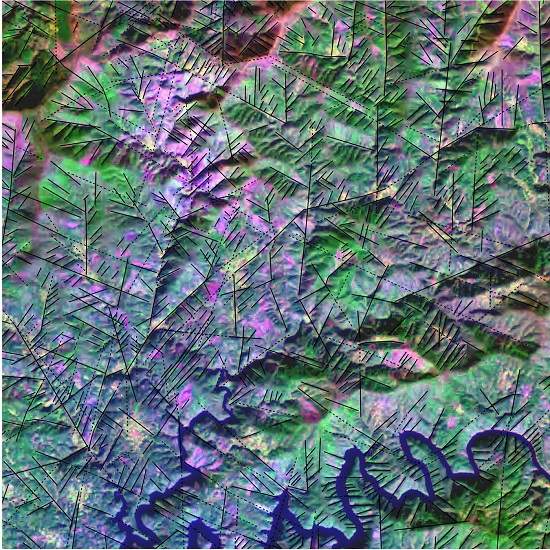Remote Sensing for Mineral Exploration in Central Portugal
Abstract
:1. Introduction
2. Geological Setting
2.1. Mineral Occurrences in Góis—Castanheira de Pêra
2.1.1. Sn-W Occurrences
2.1.2. Au-Ag Occurrences
3. Materials and Methods
3.1. Materials
3.1.1. Satellite Imagery
3.1.2. Elevation Data
3.1.3. Radiometric Data
3.1.4. Geological and Structural Mapping
3.2. Methods
3.2.1. Satellite Imagery and Elevation Data Processing
- B6/B7—the clay ratio is used for distinguishing argillitic and non-argillitic materials;
- B4/B2—the iron oxide ratio allows the contrast between FeO and non-FeO materials;
- B6/B5—the ferrous mineral ratio is used to enhance iron-bearing minerals;
- B4/B5—this ratio is used for contrasting rocks/soil and vegetation;
- (B5 − B4)/(B5 + B4)—called NDVI (normalised difference vegetation index), this ratio is used for distinguishing between vegetation and non-vegetation.
3.2.2. Geological Interpretation and Field Validation
3.2.3. Lineament Analysis and Data Integration
3.2.4. Target Selection
4. Results
4.1. Digital Image Processing
4.1.1. Satellite Imagery
4.1.2. Elevation Data
4.1.3. Preliminary Lineament Extraction
4.2. Field Validation and Lineament Reinterpretation
4.3. Lineament Analysis
4.4. Data Integration
4.4.1. Lineaments and Geological Mapping
4.4.2. Lineaments and Mineral Occurrences
4.4.3. Lineaments and Radiometric Data
4.4.4. Lineaments and Toponymy
4.5. Target Selection and Prioritisation
- (1) Geology—geology was used as an exclusion criterion; the areas corresponding to the Meso-Cenozoic basins, the Ordovician Quartzites and the Coentral granite are most probably not related with any primary Sn-W or Au-Ag occurrences, and thus were excluded.
- (2) Mineral occurrences—areas of influence were created around all known mineral occurrences (1 km); the proximity to known mineral occurrences or the alignment according to trends similar to those of the ore bodies are factors that should be considered for they increase the probability for a given location to have mineral occurrences of interest. Zones with trends similar to those of adjacent metallogenic belt were also selected.
- (3) Lineaments—areas with high lineament density values (>4 km/km2) and locations near lineaments or lineament trends which may be directly related to metallogenic belts, were selected and considered to have a very high probability of mineral occurrences.
- (4) Radiometric data—places of positive radiation anomalies (total gamma radiation values greater than 67.4 nG/h) were considered possible locations of mineral occurrences.
- (5) Toponymy—areas of influence (500 m) were created around all locations where toponymy indicates a possible association with mineral occurrences or mining works.
5. Conclusions
Acknowledgments
Author Contributions
Conflicts of Interest
References
- Rajesh, H.M. Application of remote sensing and GIS in mineral resource mapping—An overview. J. Mineral. Petrol. Sci. 2004, 99, 83–103. [Google Scholar] [CrossRef]
- Vincent, R.K. Fundamentals of Geological and Environmental Remote Sensing; Prentice Hall: Upper Saddle River, NJ, USA, 1997; p. 366. ISBN 978-0133487800. [Google Scholar]
- Gupta, R.P. Remote Sensing Geology, 2nd ed.; Springer-Verlag: Berlin/Heidelberg, Germany, 2003; p. 655. ISBN 978-3-642-07741-8. [Google Scholar]
- Prost, G.L. Remote Sensing for Geoscientists—Image Analysis and Integration, 3rd ed.; CRC Press: Boca Raton, FL, USA, 2014; p. 622. ISBN 9781466561748. [Google Scholar]
- Manuel, R. Contribuição da Detecção Remota Para a Prospecção de Jazigos de Sn. W e Au na região de Góis. Master’s Degree, NOVA University of Lisbon, Lisbon, Portugal, December 2015. [Google Scholar]
- Martins, L. Mineral Resources of Portugal; DGEG: Lisbon, Portugal, 2012; p. 71.
- LNEG—Laboratório Nacional de Energia e Geologia. Available online: http://www.lneg.pt/ (accessed on 29 September 2017).
- Neiva, J.M.C. Jazigos portugueses de cassiterite e volframite. Comun. Serv. Geol. Port. 1944, 25, 251. [Google Scholar]
- Thadeu, D. Características da mineralização hipogénica estano-volframítica portuguesa. Bol. Ord. Eng. 1965, 10, 61–81. [Google Scholar]
- Carvalho, D. Lineament patterns and hypogene mineralization in Portugal. Est. Notas Trab. Serv. Fom. Min. 1974, 23, 91–106. [Google Scholar]
- Thadeu, D. Hercynian paragenetic units of the Portuguese part of the Hesperic Massif. Bol. Soc. Geol. Portg. 1976, 20, 247–276. [Google Scholar]
- Goinhas, J.; Viegas, L. Província metalogénica estanífera e tungsténica ibérica. Estudos, Notas e Trabalhos do SFM 1983, 25, 147–178. [Google Scholar]
- Mateus, A.; Noronha, F. Sistemas mineralizantes epigenéticos na Zona Centro-Ibérica; expressão da estruturação orogénica Meso- a Tardi-Varisca. In Ciências Geológicas-Ensino e Investigação e Sua História; Neiva, J.M.C., Ribeiro, A., Victor, M., Noronha, F., Ramalho, M., Eds.; Associação Portuguesa de Geólogos and Sociedade Geológica de Portugal: Lisbon, Portugal, 2010; Volume 2, pp. 47–61. [Google Scholar]
- Noronha, F.; Ribeiro, M.A.; Almeida, A.; Dória, A.; Guedes, A.; Lima, A.; Martins, H.C.; Sant’Ovaia, H.; Nogueira, P.; Martins, T.; et al. Jazigos filonianos hidrotermais e aplitopegmatíticos espacialmente associados a granitos (norte de Portugal). In Geologia de Portugal; Dias, R., Araújo, A., Terrinha, P., Kullberg, J.C., Eds.; Escolar Editora: Portugal, 2013; Volume 1, pp. 377–402. ISBN 9789725923641. [Google Scholar]
- European Commission. Report on Critical Raw Materials for the EU—Critical Raw Materials Profiles; European Commission: Brussels, Belgium, 2014; p. 205. [Google Scholar]
- European Commission. Report on Critical Raw Materials for the EU—Non-Critical Raw Materials Profiles; European Commission: Brussels, Belgium, 2014; p. 138. [Google Scholar]
- European Commission. Report on Critical Raw Materials for the EU. Report of the Ad Hoc Working Group on Defining Critical Raw Materials; European Commission: Brussels, Belgium, 2014; p. 41. [Google Scholar]
- Cunha, T.; Soares, A.F.; Marques, J.F.; Rocha, R.B.; Sequeira, A.J.D.; Sousa, M.B.; Pereira, E.; Santos, J.R. Sheet 19-D (Coimbra-Lousã), Geological Map of Portugal at 1:50,000 Scale; LNEG: Alfragide, Portugal, 2005.
- Oliveira, J.T.; Pereira, E.; Ramalho, M.; Antunes, M.T.; Monteiro, J.H. (Coord.). Geological Map of Portugal 1:500,000 Scale, 5th ed.; LNEG: Alfragide, Portugal, 1992.
- Meireles, C.; Sequeira, A.J.D.; Castro, P.; Ferreira, N. New data on the lithostratigraphy of Beiras Group (Schist Greywacke Complex) in the region of Góis-Arganil-Pampilhosa da Serra (Central Portugal). Cadernos Lab. Xeolóxico de Laxe 2013, 37, 105–124. [Google Scholar]
- Julivert, M.; Fontboté, J.M.; Ribeiro, A.; Conde, L. Mapa Tectónico de la Península Ibérica y Baleares; IGME: Madrid, Spain, 1974; p. 94. [Google Scholar]
- Oliveira, J.M.S. Geological, mineralogical and lithogeochemical studies in the Gois and Vila Pouca de Aguiar-Vila Real region, Portugal. Estudos, Notas e Trabalhos do SFM 1990, 32, 65–76. [Google Scholar]
- Medina, J.; Sequeira, A.; Silva, A.F.; Oliveira, J.T.; Rodriguez-Alonso, M.D. O Complexo Xisto-Grauváquico (CXG) da região de V.N. Poiares-Arganil-Mortágua. In Livro guia das excursões do V Congresso Nacional de Geologia; Oliveira, J.T., Pereira, E., Eds.; LNEG-LGM: Alfragide, Portugal, 1998; pp. 135–158. [Google Scholar]
- LNEG-LGM. Geological Map of Portugal 1:1,000,000, 3rd ed.; LNEG-LGM: Alfragide, Portugal, 2010.
- Gomes, E.M.C.; Antunes, I.M.H.R. O granito de Coentral revisitado: Idade U-Pb de zircão. In Proceedings of the VIII Congresso Ibérico de Geoquímica—Livro de Actas, Castelo Branco, Portugal, 24–28 September 2011; IPCB: Castelo Branco, Portugal, 2011; Volume 1, pp. 235–239. ISBN 972-989-8196-16-3. [Google Scholar]
- Ribeiro, A.; Kullberg, M.C.; Kullberg, J.C.; Manuppella, G.; Phipps, S. A review of Alpine tectonics in Portugal: Foreland detachment in basement and cover rocks. Tectonophysics 1990, 184, 357–366. [Google Scholar] [CrossRef]
- Cathelineau, M.; Boiron, M.C.; Palomero, F.G.; Urbano, R.; Florido, P.; Pereira, E.; Noronha, F.; Barriga, F.J.A.S.; Mateus, A.; Yardley, B.; et al. Multidisciplinary Studies of Au-Vein Formation. Application to the Western Part of the Hesperian Massif (Spain-Portugal). Project MA2M-CT90-0033, Multiannual R & D Programme (1990–1992) on Primary Raw Materials and Recycling of Nonferrous Metals, CEC, Final Report; Centro de Geologia da Universidade do Porto: Porto, Portugal, 1993; p. 391. [Google Scholar]
- Martínez Catalán, J.R. The Central Iberian arc, an orocline centered in the Iberian Massif and some implications for the Variscan belt. Int. J. Earth Sci. 2012, 101, 1299–1314. [Google Scholar] [CrossRef]
- Gutierréz-Alonso, G.; Collis, A.S.; Fernández-Suárez, J.; Pastor-Galán, D.; González-Clavijo, E.; Jourdan, F.; Weil, A.B.; Johnston, S.T. Dating of lithospheric buckling: 40Ar/39Ar ages of syn-orocline strike–slip shear zones in northwestern Iberia. Tectonophysics 2015, 643, 44–54. [Google Scholar] [CrossRef]
- Noronha, F.; Cathelineau, M.; Boiron, M.; Banks, D.; Dória, M.; Ribeiro, M.; Nogueira, P.; Guedes, A. A three-stage fluid flow model for Variscan gold metallogenesis in Northern Portugal. J. Geoch. Explor. 2000, 71, 209–224. [Google Scholar] [CrossRef]
- Freire, M.; Chichorro, M.; Matias, F.; Amaral, P.K.; Pereira, M.F.; Brandão, J.S. High resolution geological structural mapping for prospecting gold and arsenic in sheared granites: A case study of the Santo António gold deposits (Penedono). In Livro de Resumos do X Congresso Ibérico de Geoquímica/XVIII Semana de Geoquímica; LNEG: Alfragide, Portugal, 2015; pp. 84–87. ISBN 978-989-675-039-8. [Google Scholar]
- Sequeira, A.J.D.; Cunha, P.P.; Sousa, M.B. A reactivação de falhas, no intenso contexto compressivo desde meados do Tortoniano, na região de Espinhal-Corja-Caramulo (Portugal Central). Comun. Inst. Geol. Min. 1997, 83, 95–126. [Google Scholar]
- Cerveira, A. Notas sobre as minas de ouro da Serra da Louzã. Bol. Soc. Geol. Port. 1946, 6, 245–255. [Google Scholar]
- SIORMINP—Sistema de Informação de Ocorrências e Recursos Minerais Portugueses; LNEG: Alfragide, Portugal, 2000. Available online: http://geoportal.lneg.pt/geoportal/egeo/bds/siorminp/ (accessed on 29 September 2017).
- Parra, A.A.H.N. Resultados da aplicação do método mineralométrico com base em solos superficiais à prospecção de jazidas primárias de cassiterite, volframite e ouro na região de Góis. Estudos, Notas e Trabalhos 1990, 32, 83–92. [Google Scholar]
- Oliveira, M.A. Geological Report on Couto Mineiro de Gois; SFM: Lisbon, Portugal, 1969; p. 16. [Google Scholar]
- Carvalho, A.D. Trabalhos de Pesquisa na Região Mineira de Góis; DGGM—SFM, Sector de Avaliação de Recursos Minerais: Lisbon, Portugal, 1986; p. 26. [Google Scholar]
- Parra, A.A.H.N. Reconhecimento Prévio dos Filões Mineralizados em Volframite da Mina da Senhora da Guia; DGGM—SFM: Lisbon, Portugal, 1987; p. 15. [Google Scholar]
- Nogueira Ramos, J. Góis, Tempo de Volfrâmio. Entre Memória e História; Movimento de Cidadãos por Góis: Góis, Portugal, 2009; pp. 161–194. [Google Scholar]
- Bengala, J.A.M. Região de Góis (243)—Relatório do Perfil Gravimétrico OB N-78gr-W; DGGM—SFM, Divisão de Geofísica: Lisbon, Portugal, 1985; p. 4. [Google Scholar]
- Fonseca, J.D.; Rodrigues, L.F. Prospecção Por Reflexão Sísmica na Zona da Mina do Vale do Pião (Góis); LNEC, Departamento de Geotecnia: Lisbon, Portugal, 1986; p. 5. [Google Scholar]
- Torres, L.M. Relatório Preliminar da Prospecção Sísmica Executada no Couto Mineiro de Góis em Colaboração com o Laboratório Nacional de Engenharia Civil (LNEC); DGGM—SFM, Divisão de Geofísica: Lisbon, Portugal, 1985; p. 9. [Google Scholar]
- Carvalho, A.D. Mina de ouro da Escádia Grande—Apontamento Monográfico de Pesquisa; DGGM–SFM, Sector de Avaliação de Recursos Minerais: Lisbon, Portugal, 1986; p. 26. [Google Scholar]
- O’Leary, D.W.; Freidman, J.D.; Pohn, H.A. Lineament, linear, lineation: Some proposed new definitions for old terms. Geol. Soc. Am. Bull. 1976, 87, 1463–1469. [Google Scholar] [CrossRef]
- Rabaça, T.J.L.; Conde, L.N.; Pinto, A.F.F.; Pereira, A.J.S.C. Avaliação das potencialidades técnicas de detecção remota como suporte à cartografia geológica na região central de Portugal. e-Terra 2004, 2, 14. [Google Scholar]
- USGS/NASA. Landsat 8 (L8) Data User’s Handbook; USGS/NASA: Sioux Falls, SD, USA, 2015; p. 106.
- Batista, M.J.; Torres, L.; Leote, J.; Prazeres, C.; Saraiva, J.; Carvalho, J. Carta Radiométrica de Portugal (1:500,000); LNEG: Alfragide, Portugal, 2013.
- Andrade, R.S.N. Fotointerpretação Geológica da Região de Góis; DGGM–SFM: Lisbon, Portugal, 1985; p. 8. [Google Scholar]
- Andrade, R.S.N. Programa 2.1—Prospecção de Minérios Metálicos e Radioactivos. Projecto 2.1.3—Prospecção de Metais Nobres: Ouro e Prata. Relatório de Actividade Referente ao 2° Semestre de 1990; SFM: Lisbon, Portugal, 1990. [Google Scholar]
- Borralho, V.; Parra, A. Projecto 2.4.1. Reconhecimento e Avaliação de Recursos Minerais (Região de Góis). Plano de Actividades Para 1988; DGGM–SFM: Lisbon, Portugal, 1988; p. 36. [Google Scholar]
- Parra, A.A.H.N. Jazida Estano-Volframítica de Vale Pião. Aspectos Geológicos e Cálculo Preliminar de Reservas; DGGM–SFM: Lisbon, Portugal, 1988; p. 53. [Google Scholar]
- Parra, A.A.H.N. Resultados da aplicação do método mineralométrico com base em solos superficiais em rede detalhada à descoberta de jazidas primárias de cassiterite, volframite (scheelite) e ouro na região de Góis. Estudos, Notas e Trabalhos 1993, 35, 21–33. [Google Scholar]
- Lillesand, T.M.; Kiefer, R.W.; Chipman, J.W. Remote Sensing and Image Interpretation, 6th ed.; John Willey & Sons: Hoboken, NJ, USA, 2008; p. 756. [Google Scholar]
- Chavez, P.S.; Berlin, G.L.; Sowers, L.B. Statistical method for selecting Landsat MSS ratios. J. Appl. Photogr. 1982, 8, 23–30. [Google Scholar]
- Van der Meer, F.D.; van der Werff, H.M.A.; van Ruitenbeek, F.J.A.; Hecker, C.A.; Bakker, W.H.; Noomen, M.F.; van der Meijde, M.; Carranza, E.J.M.J.; de Smeth, B.; Woldai, T. Multi- and hyperspectral geologic remote sensing: A review. Int. J. Appl. Earth Obs. Geoinf. 2012, 14, 112–128. [Google Scholar] [CrossRef]
- Drury, S.A. Image Interpretation in Geology, 2nd ed.; Chapman & Hall: London, UK, 1993; p. 283. [Google Scholar]
- Schowengerdt, R.A. Remote Sensing: Models and Methods for Image Processing, 3rd ed.; Academic Press: Orlando, FL, USA, 2007; p. 515. [Google Scholar]
- Scanvic, J.Y. Aerospatial Remote Sensing in Geology; Balkema, A.A., Ed.; CRC Press: Boca Raton, FL, USA, 1997; p. 239. [Google Scholar]
- Cengiz, O.; Sener, E.; Yagmurlu, F. A satellite image approach to the study of lineaments, circular structures and regional geology in the Golcuk Crater district and its environs (Isparta, SW Turkey). J. Asian Earth Sci. 2006, 27, 155–163. [Google Scholar] [CrossRef]
- Richards, J.A.; Jia, X. Remote Sensing Digital Image Analysis, 4th ed.; Springer: Berlin, Germany, 2006; p. 454. [Google Scholar]
- Andrade, R.S.N. Interpretação Fotogeológica da Região Centro de Portugal. Estudos, Notas e Trabalhos do SFM 1983, 25, 227–245. [Google Scholar]
- Dentith, M.; Mudge, S.T. Geophysics for the Mineral Exploration Geoscientist; Cambridge University Press: Cambridge, UK, 2014; p. 438. [Google Scholar]
- Soares, A.F.; Marques, J.F.; Sequeira, A.J.D. Explanatory Booklet of the Sheet 19-D (Coimbra-Lousã), Geological Map of Portugal at 1:50,000 Scale; INETI: Lisbon, Portugual, 2007; p. 71. [Google Scholar]
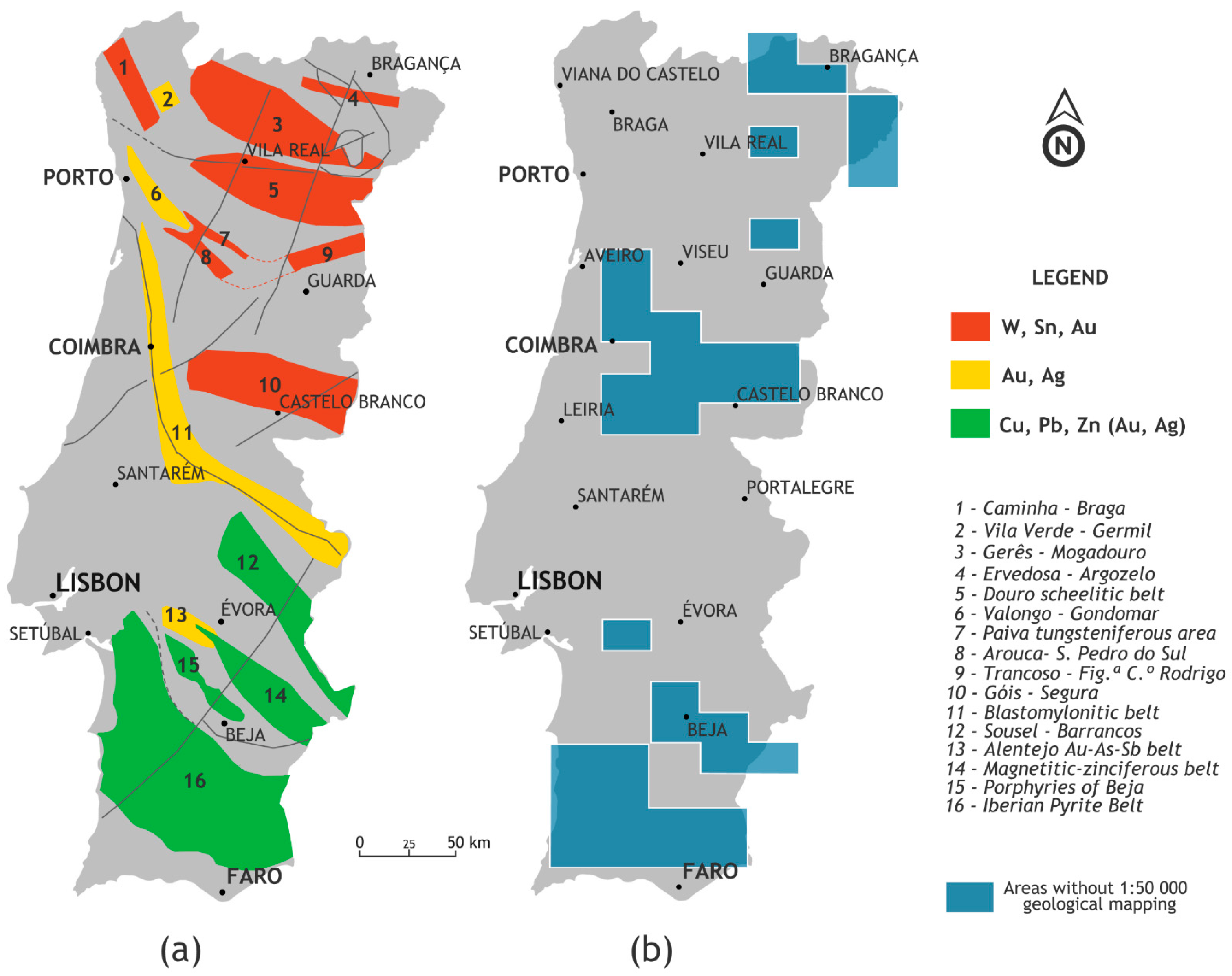
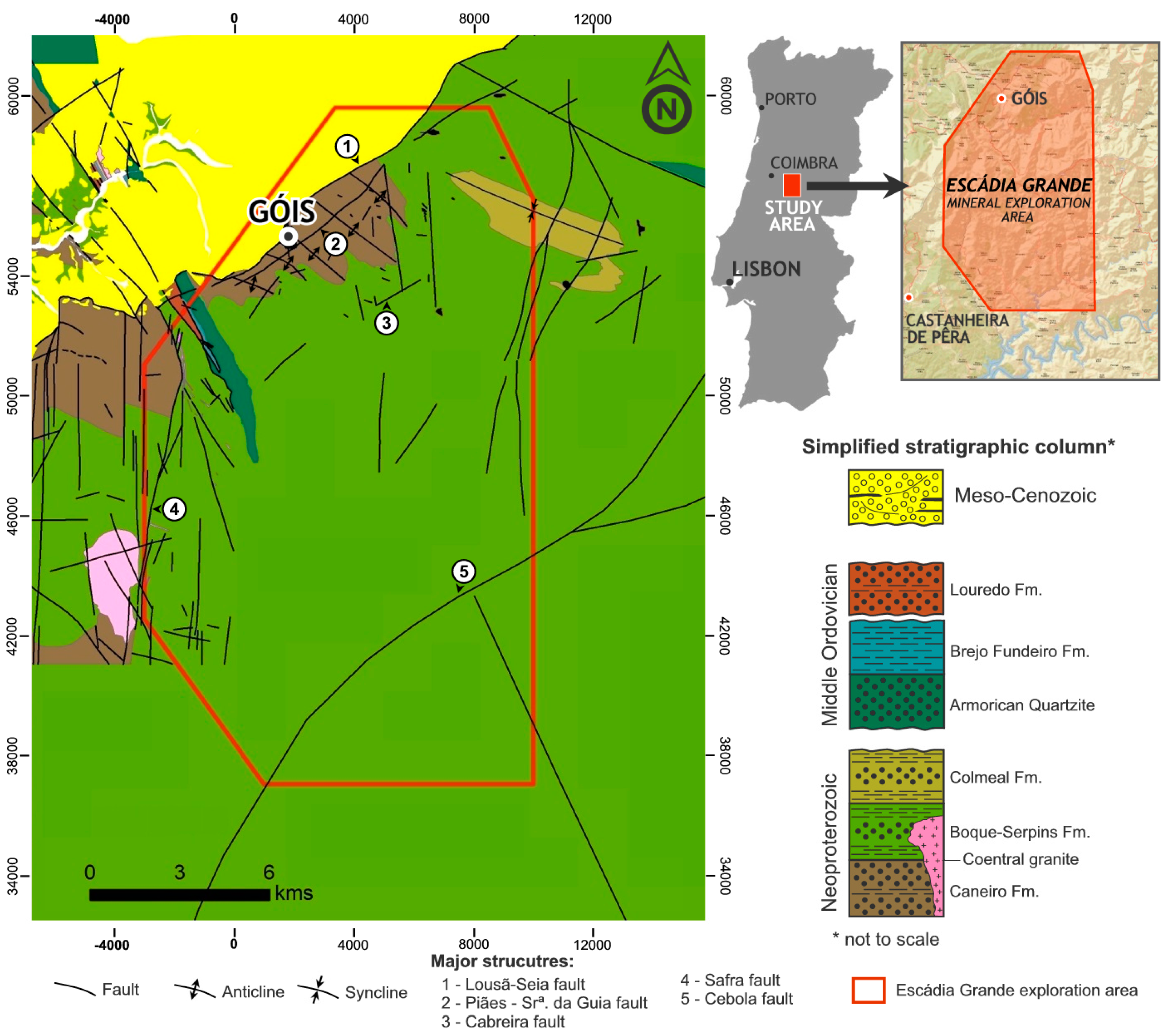
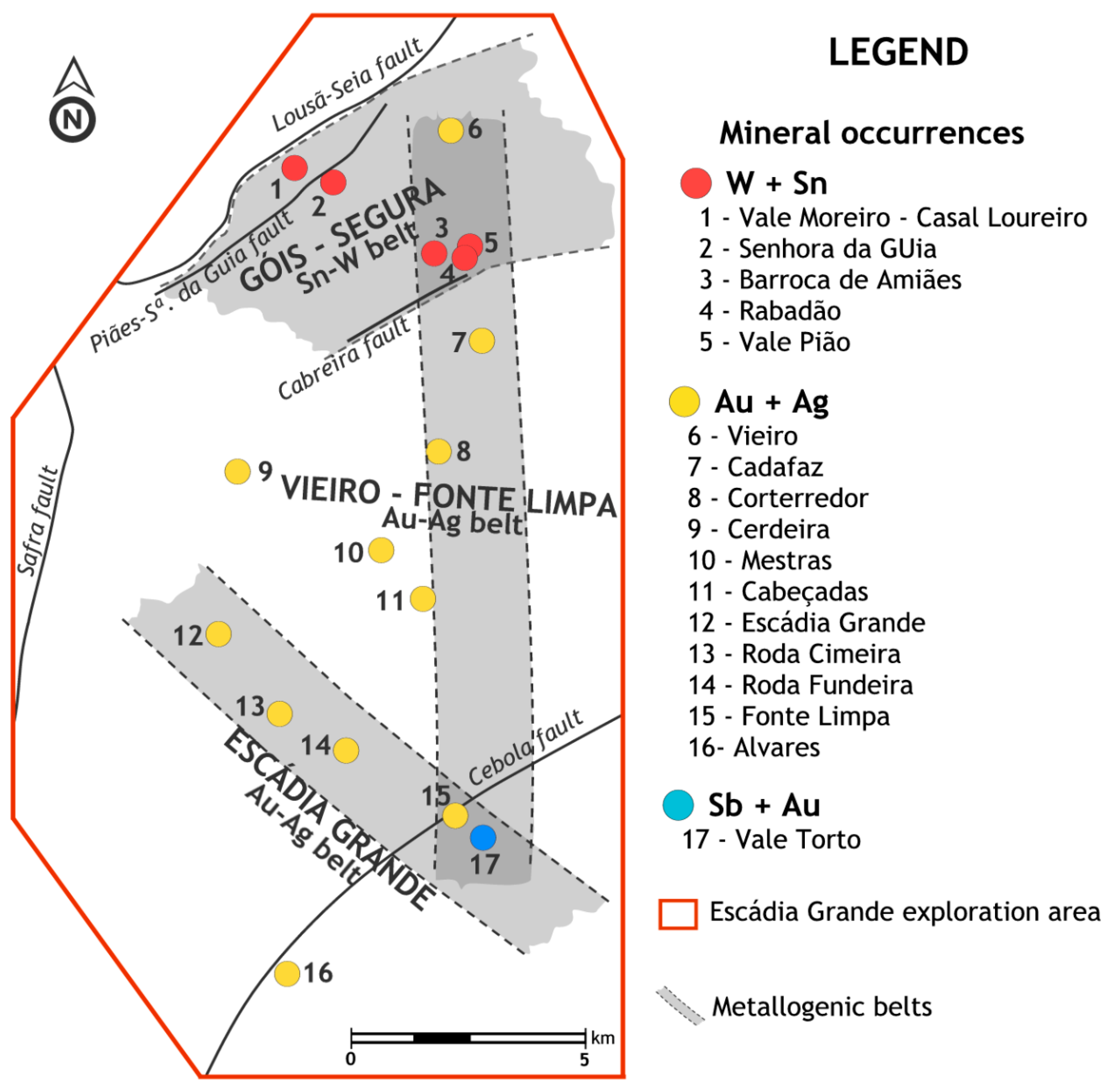

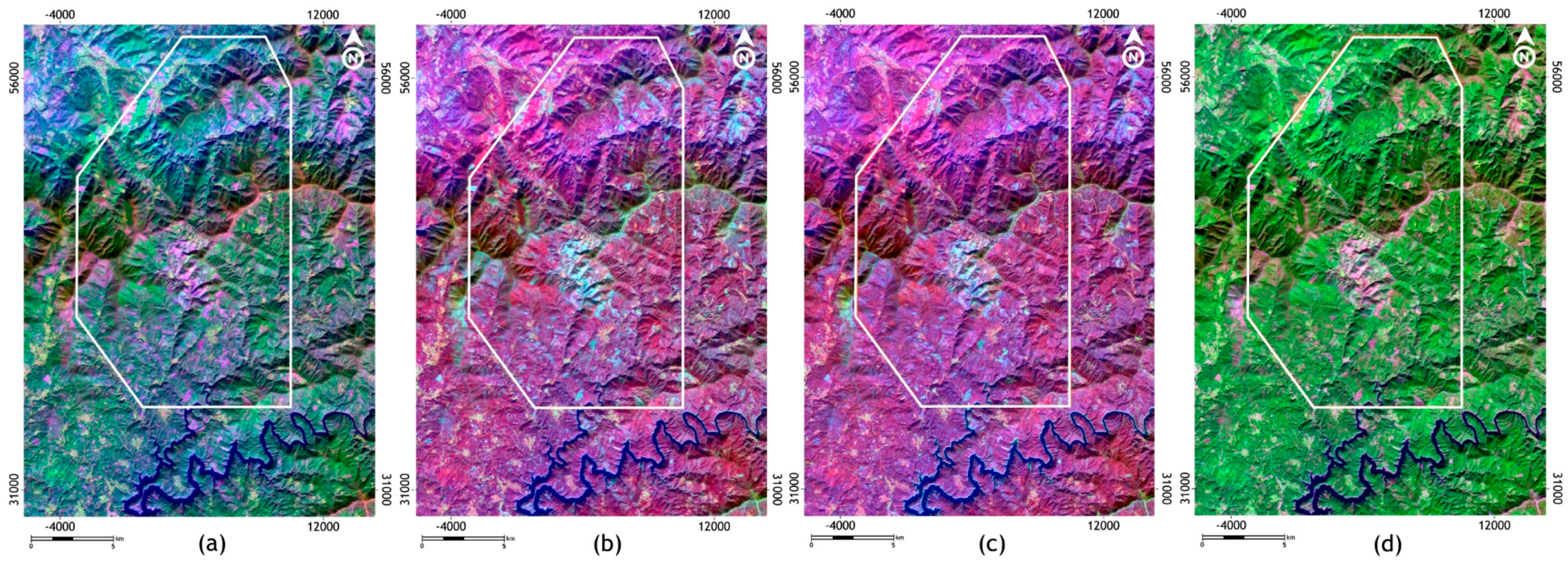

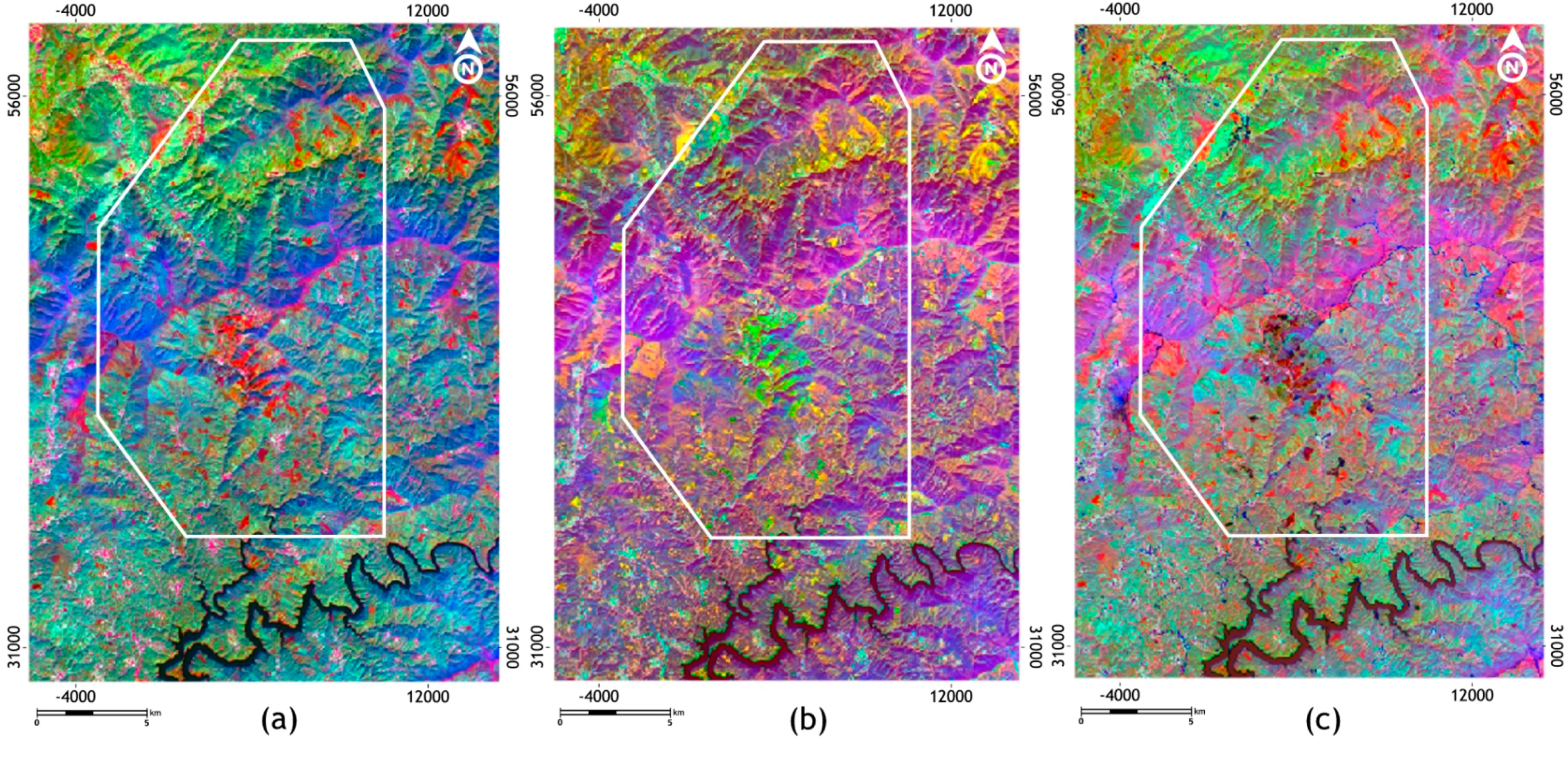
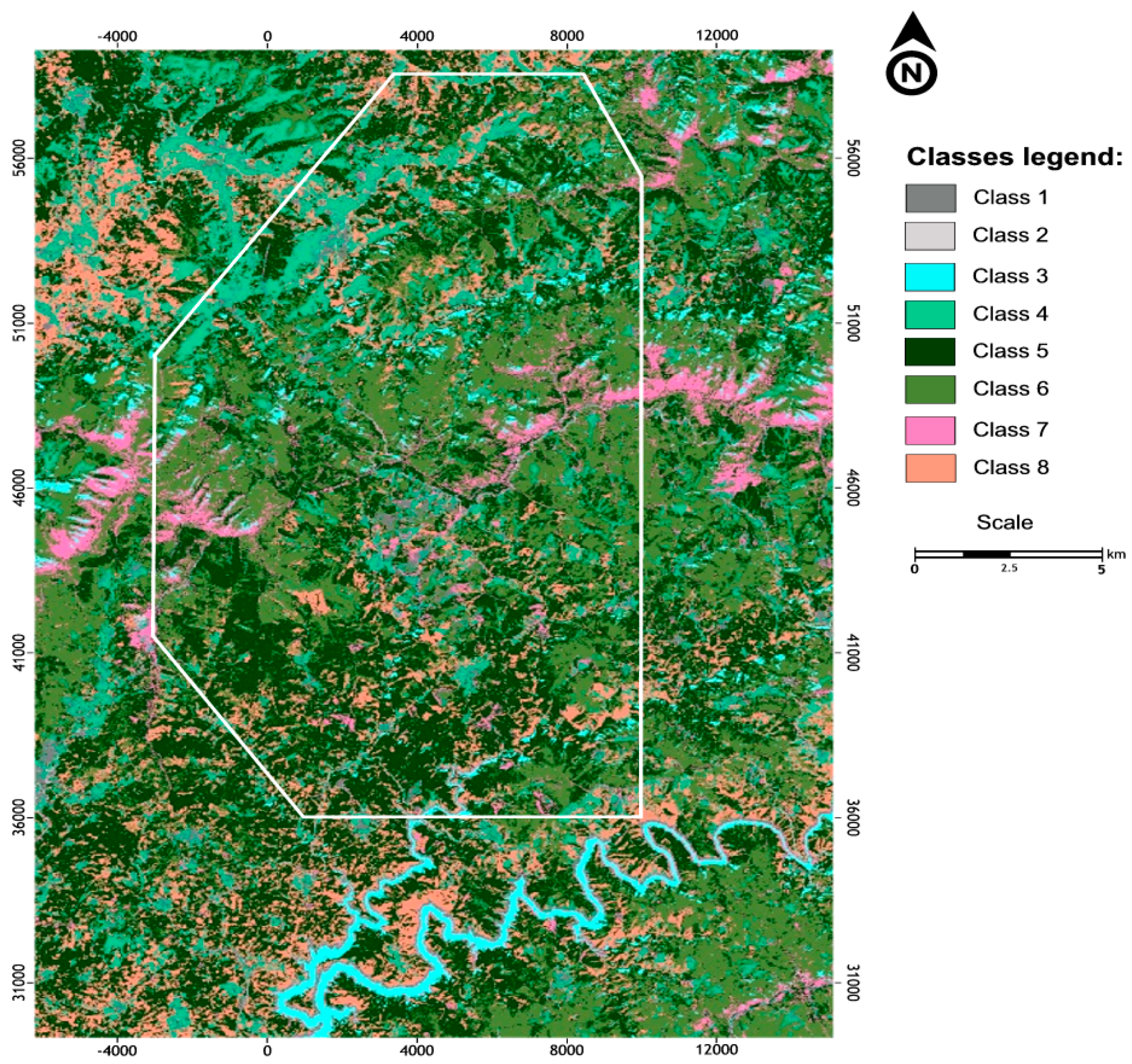
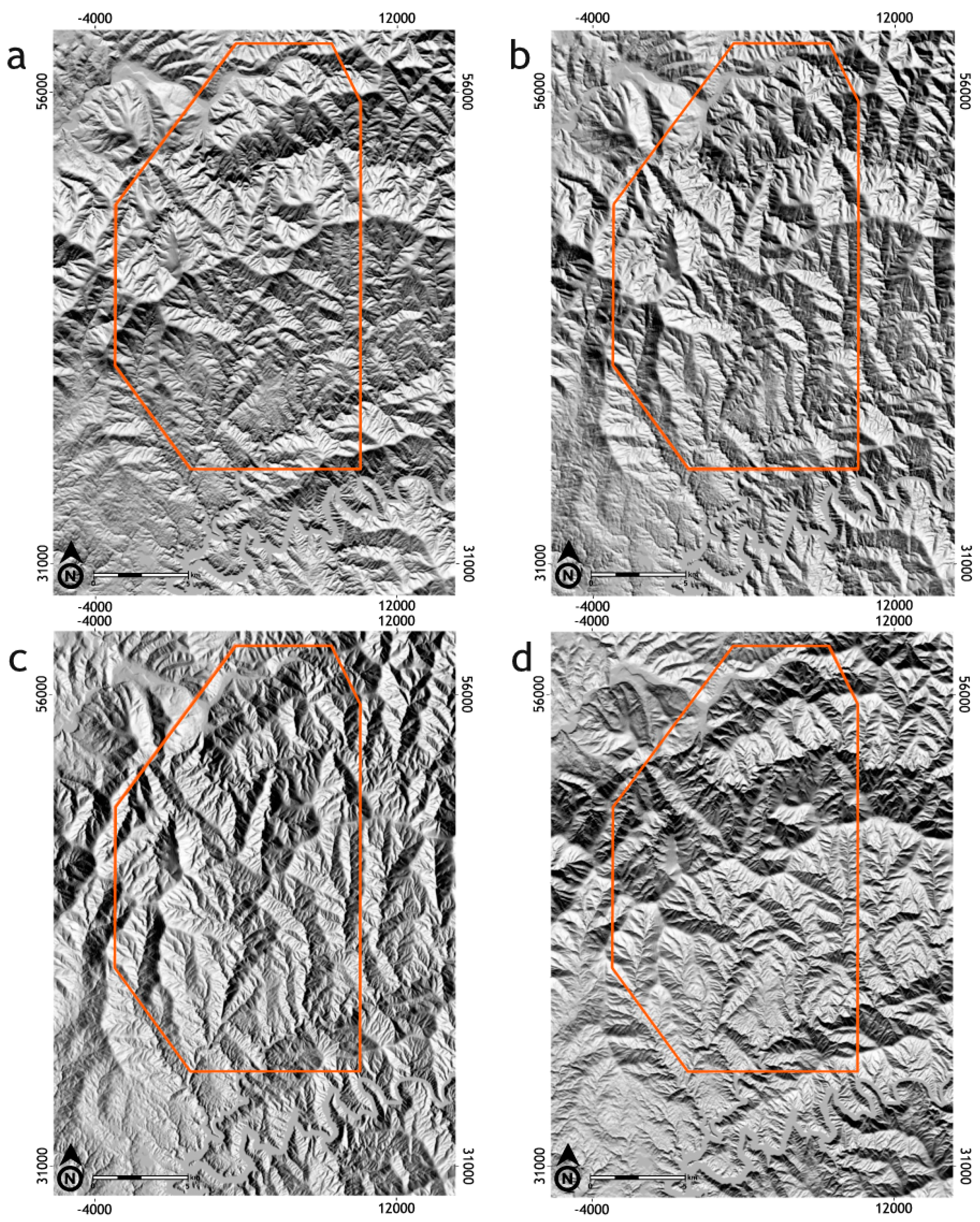
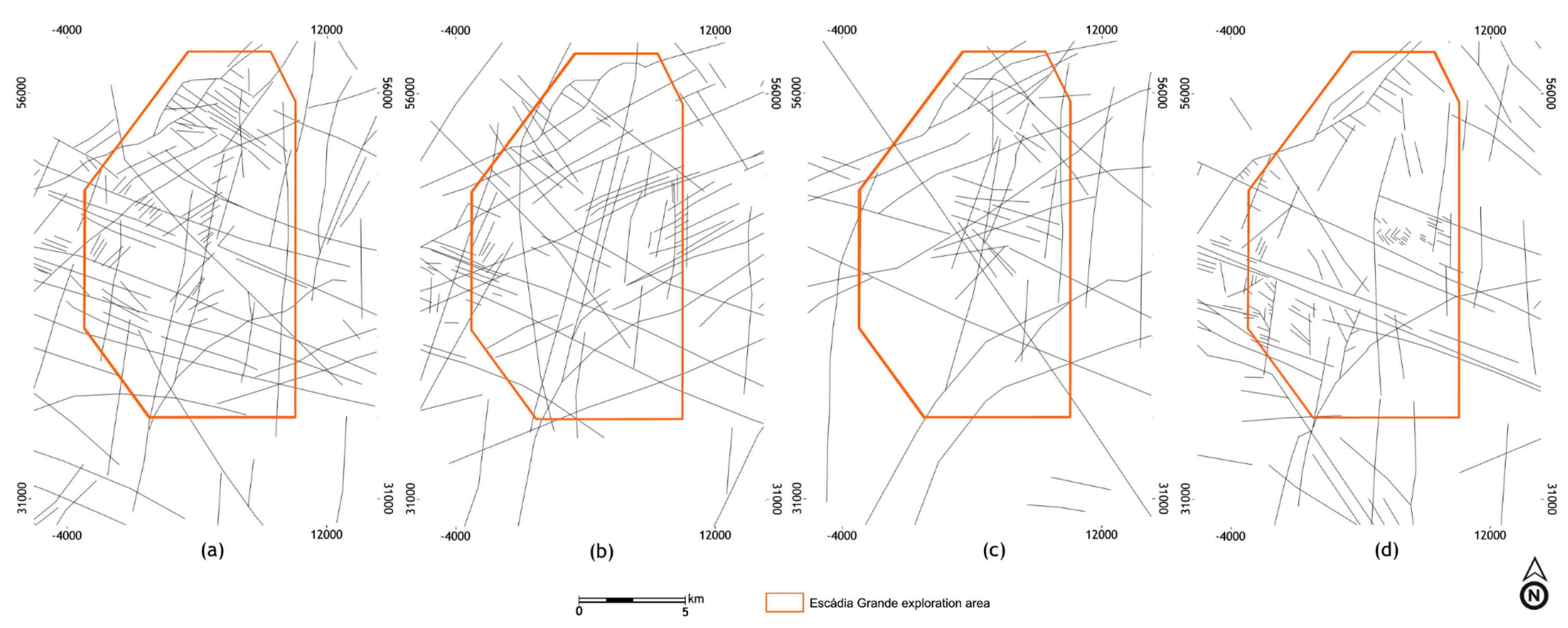
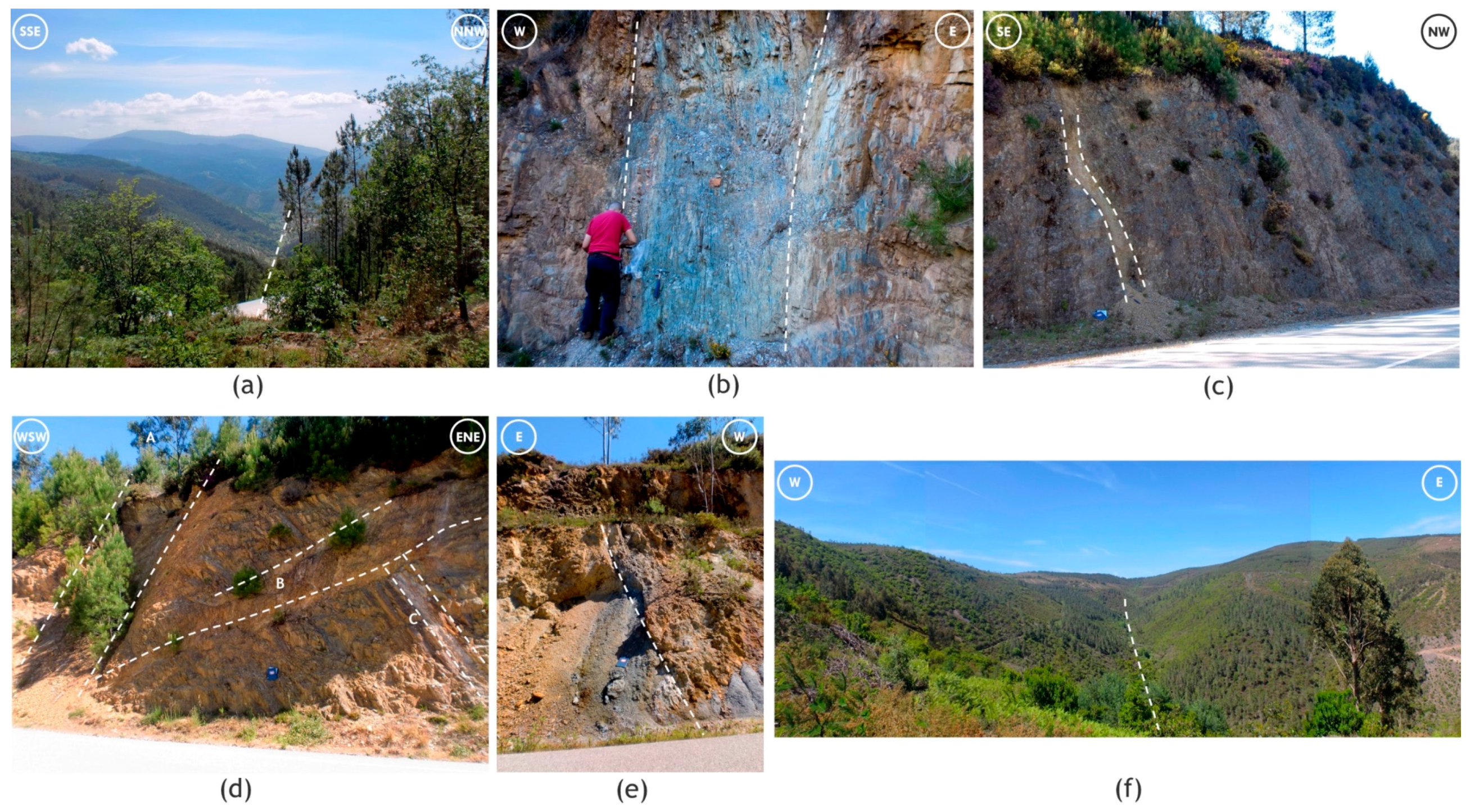
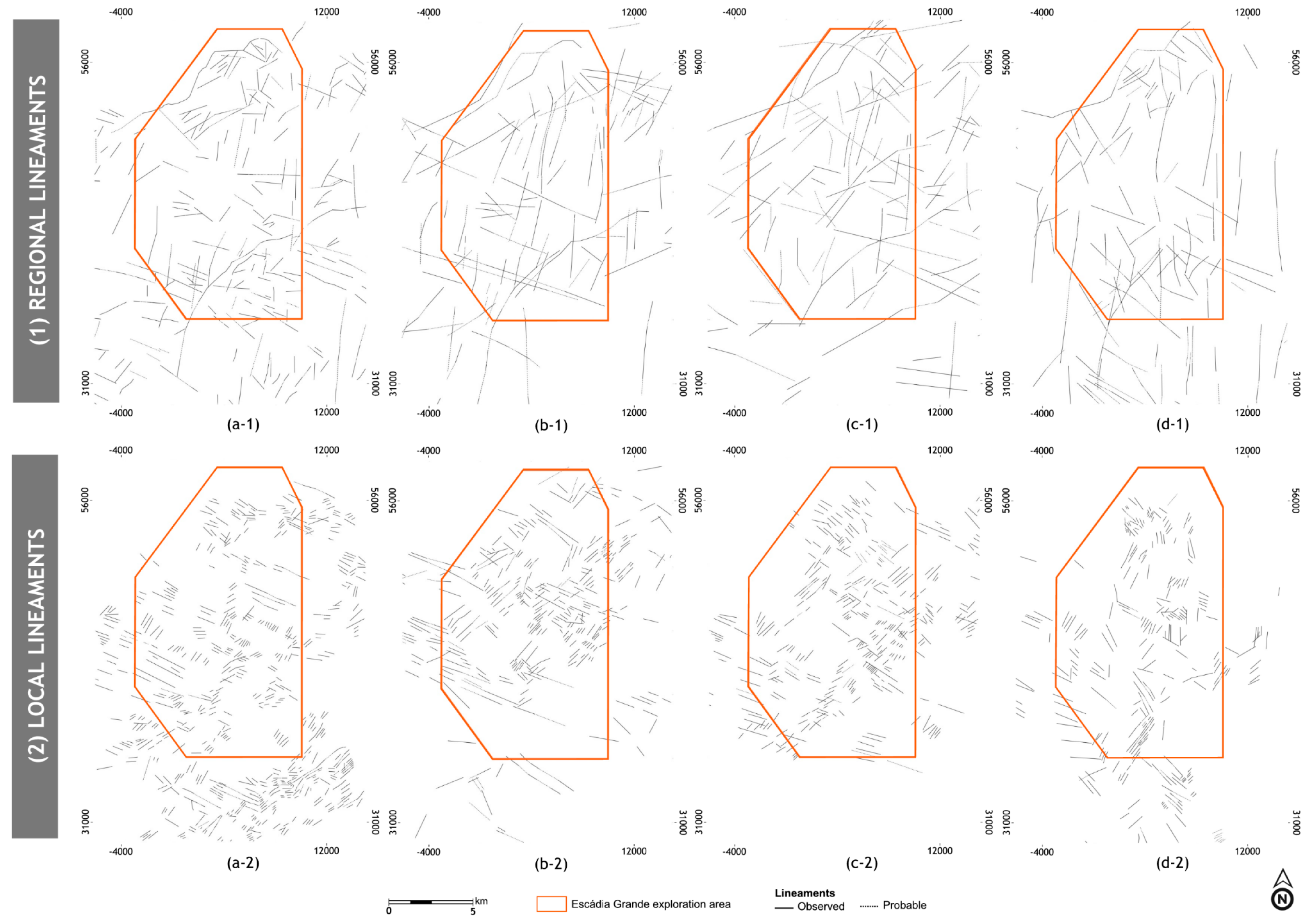
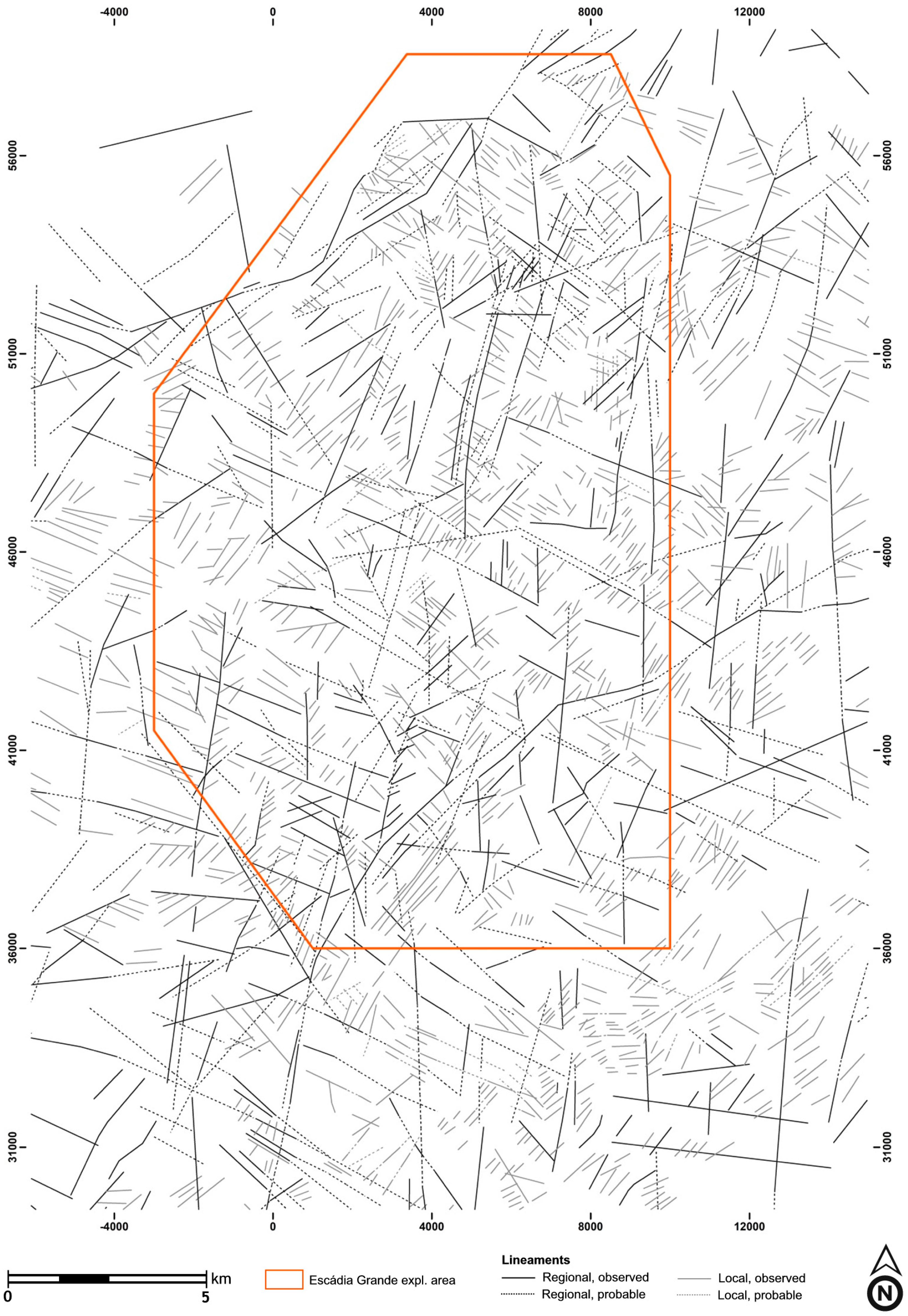

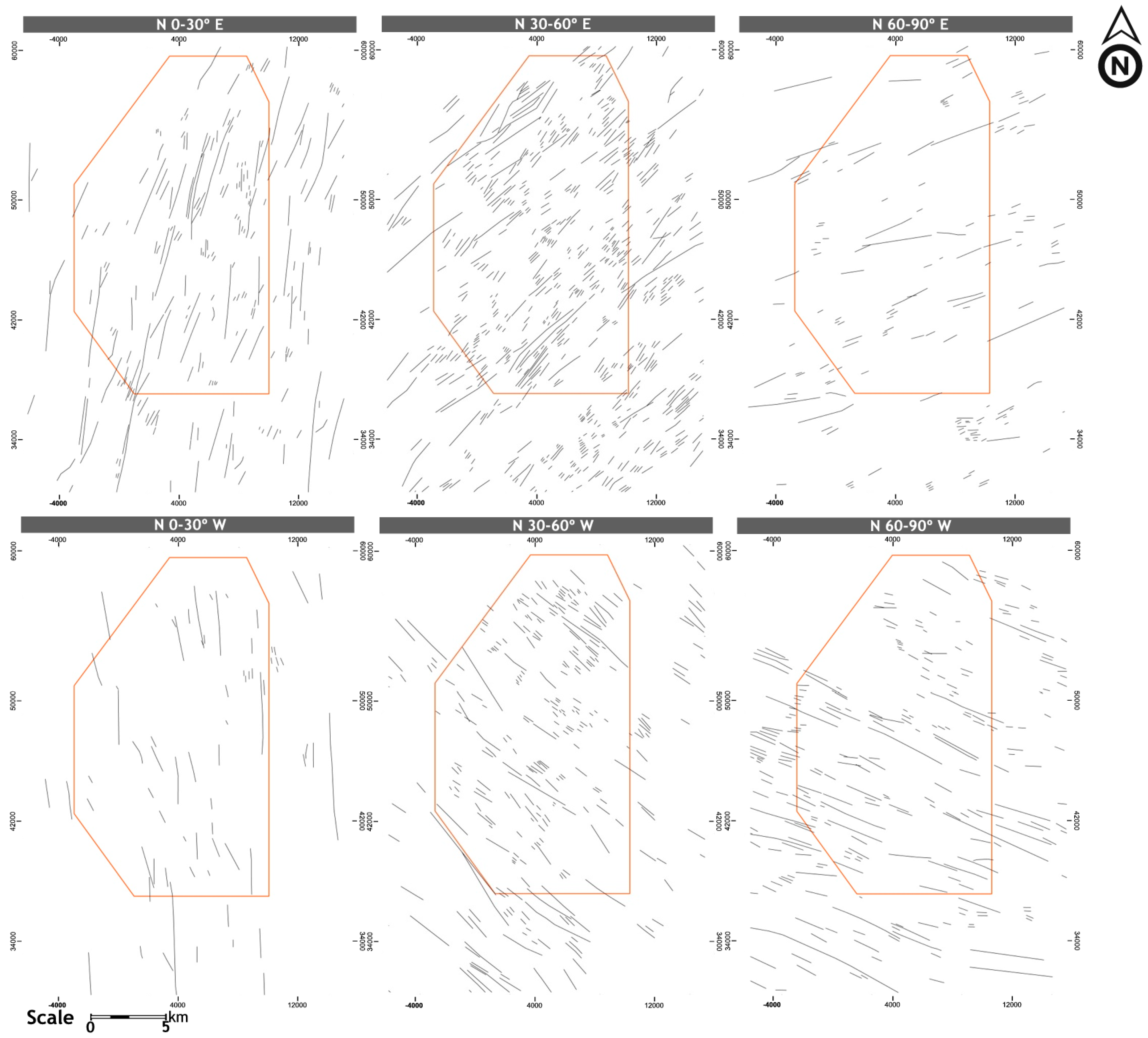

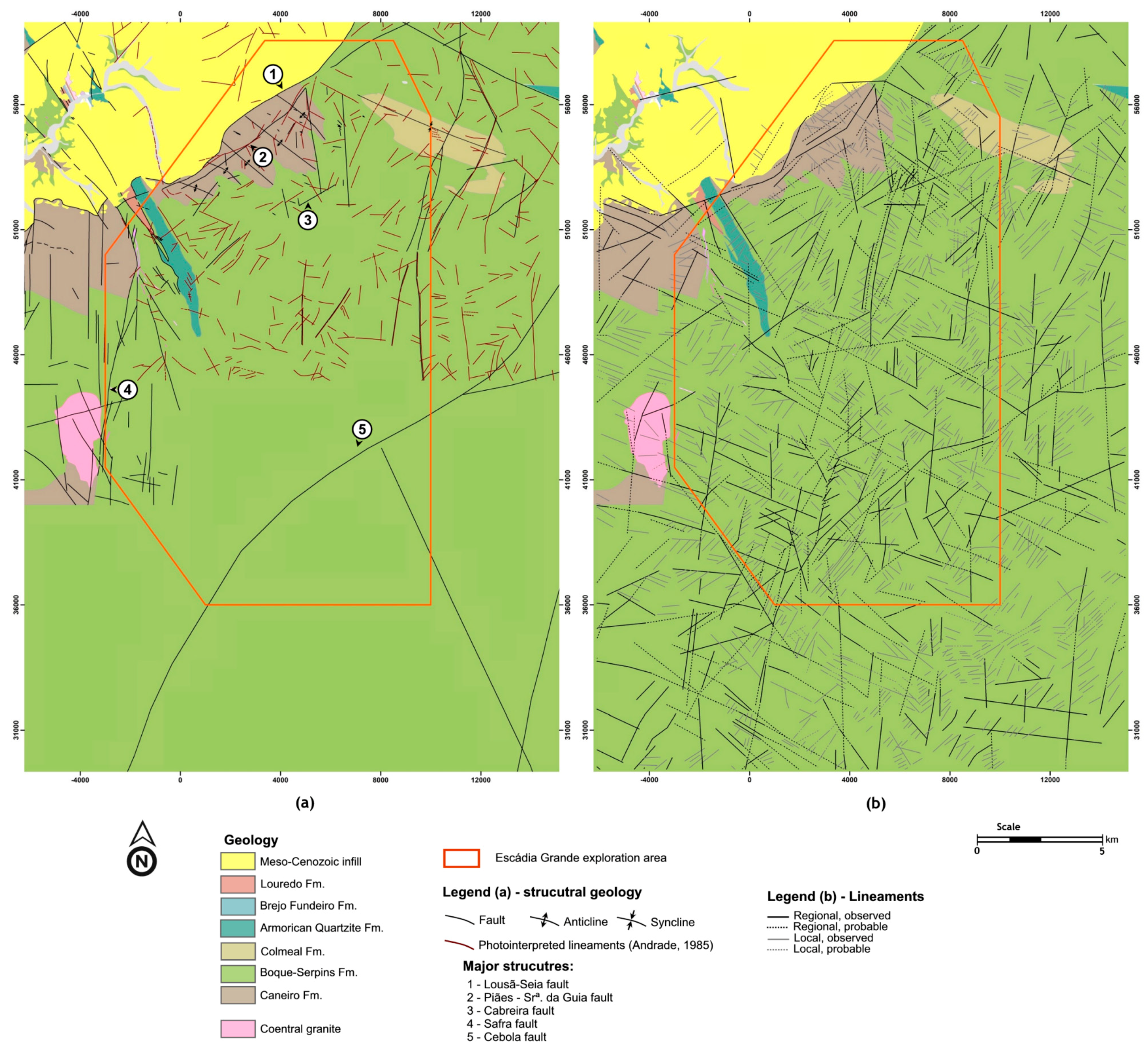

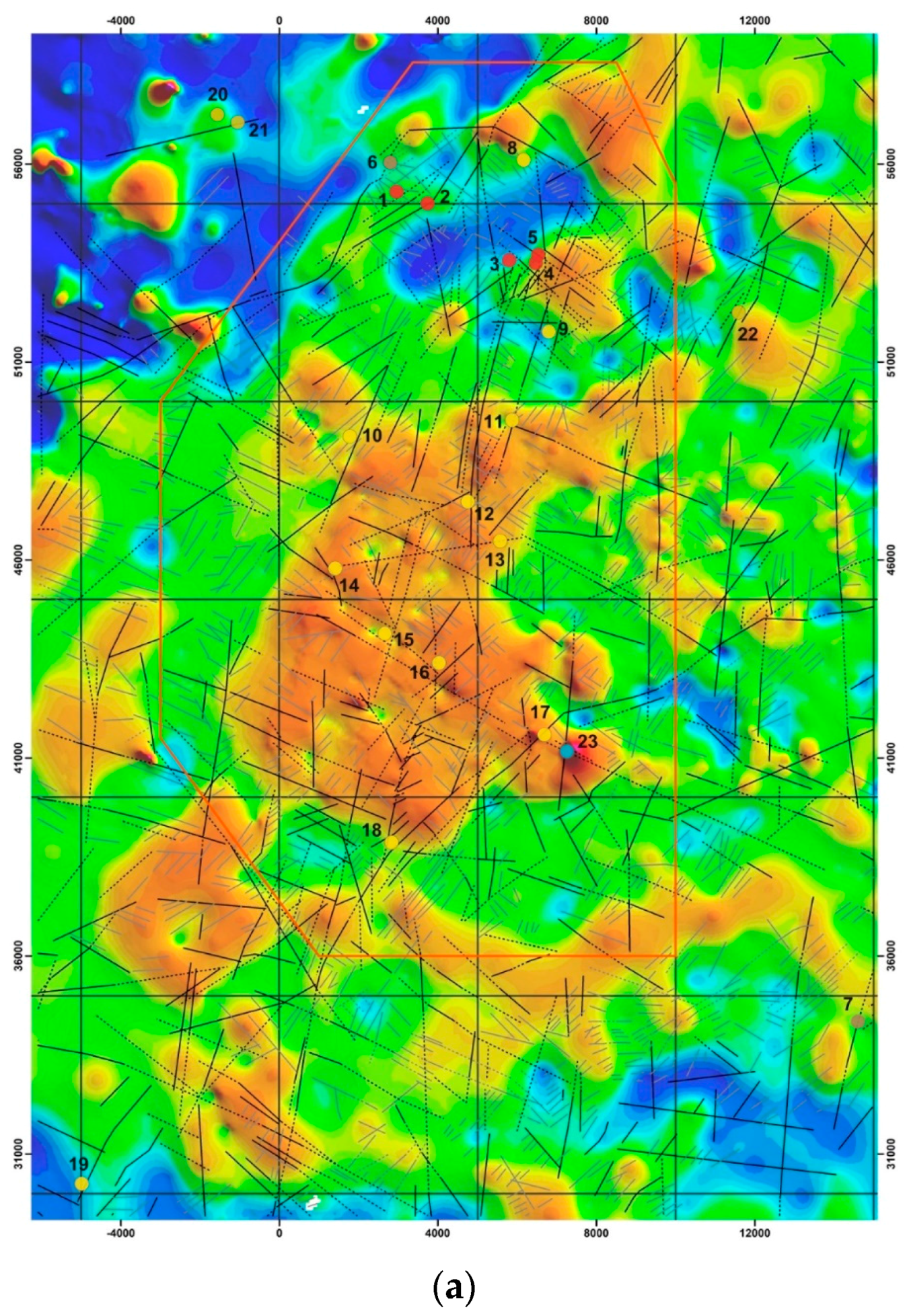
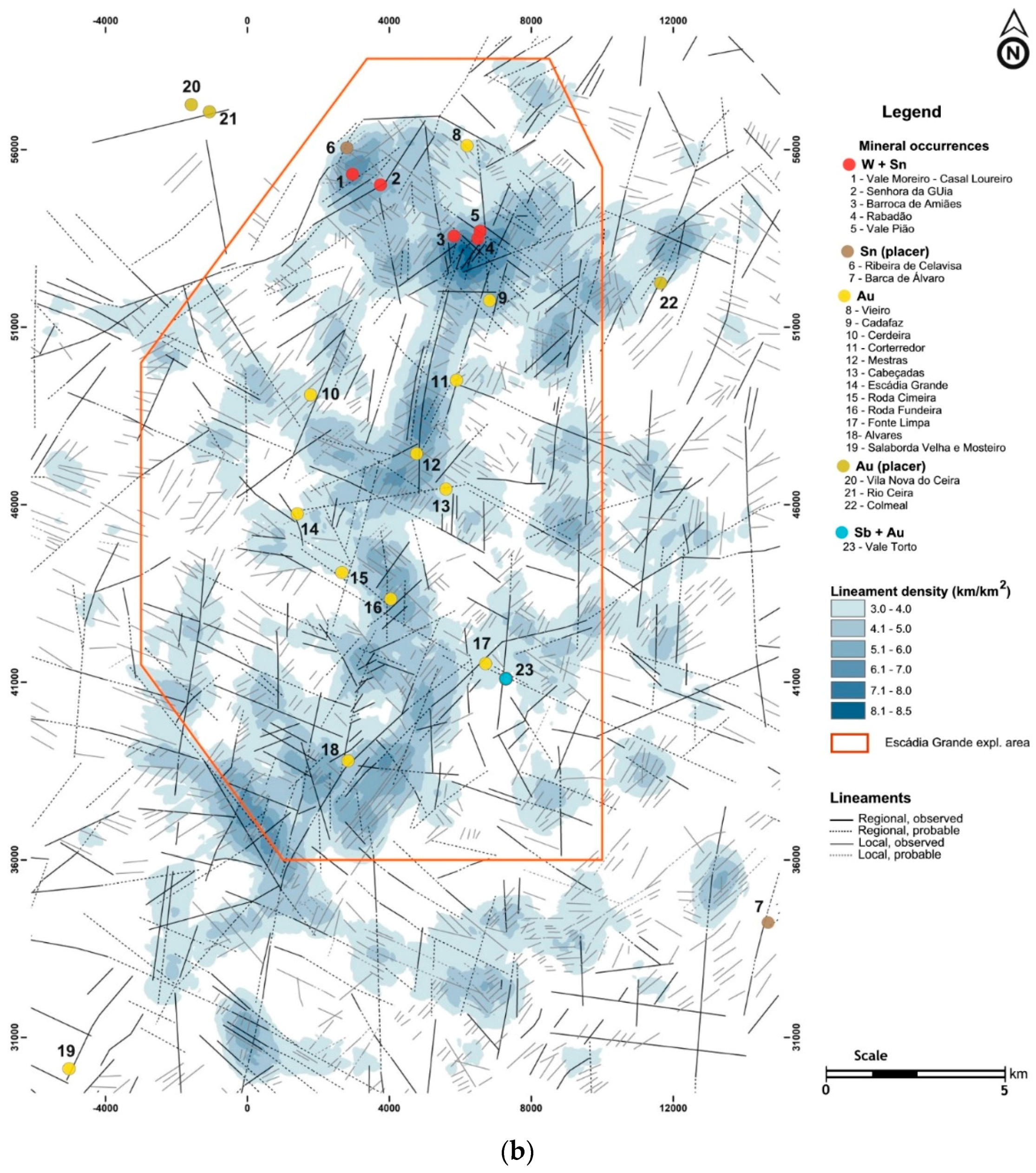
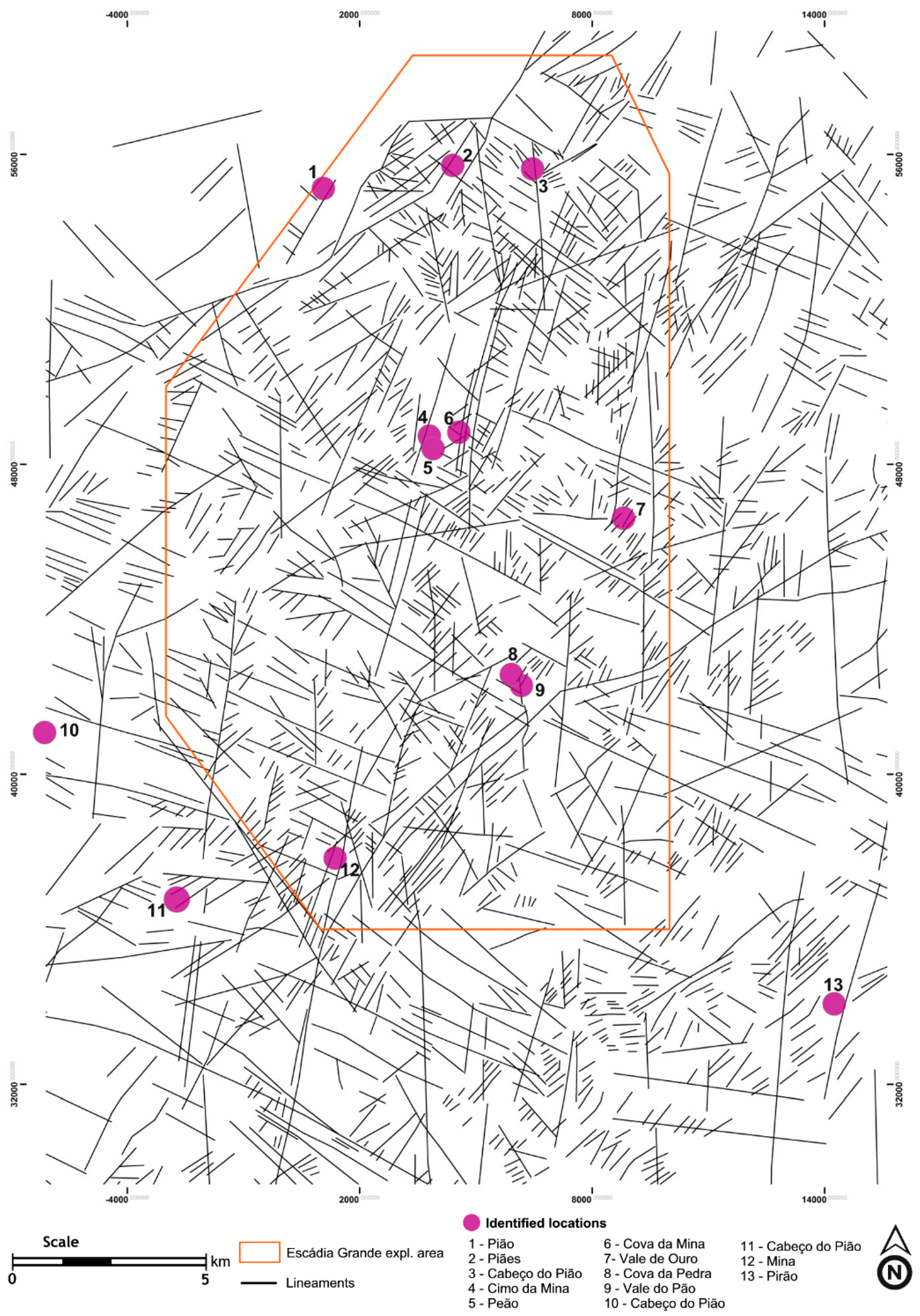
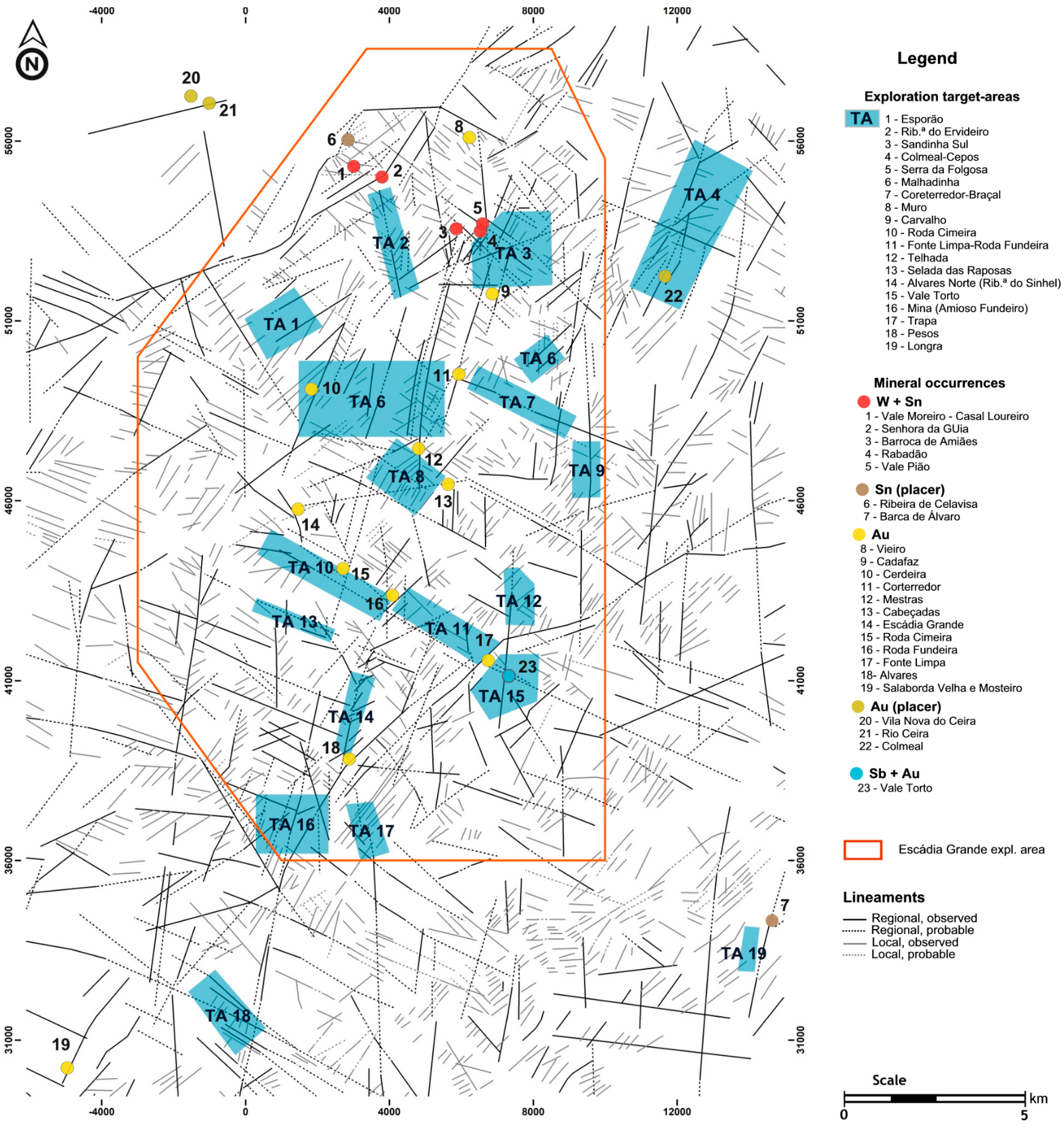
| Sensor | Band | Spectral Resolution (µm) | Spatial Resolution (m) |
|---|---|---|---|
| OLI | Band 1—Coastal | 0.435–0.451 | 30 |
| Band 2—Blue | 0.452–0.512 | 30 | |
| Band 3—Green | 0.533–0.590 | 30 | |
| Band 4—Red | 0.636–0.673 | 30 | |
| Band 5—NIR | 0.851–0.879 | 30 | |
| Band 6—SWIR-1 | 1.566–1.651 | 30 | |
| Band 7—SWIR-2 | 2.107–2.294 | 30 | |
| Band 8—Pan | 0.503–0.676 | 15 | |
| Band 9—Cirrus | 1.363–1.384 | 30 | |
| TIRS | Band 10—TIR-1 | 10.60–11.19 | 100 |
| Band 11—TIR-2 | 11.50–12.51 | 100 |
| Landsat 8 Band Combinations | OIF |
|---|---|
| 5-6-10 | 2354.41 |
| 5-7-10 | 2353.66 |
| 5-6-11 | 2260.84 |
| 5-7-11 | 2247.28 |
| 4-5-10 | 2157.02 |
| Bands | PC1 | Bands | PC2 | Bands | PC3 | Bands | PC4 |
|---|---|---|---|---|---|---|---|
| B6 | 0.61 | B5 | 0.79 | B5 | 0.22 | B6 | 0.51 |
| B5 | 0.55 | B10 | 0.08 | B6 | 0.13 | B10 | 0.05 |
| B7 | 0.40 | B11 | 0.07 | B7 | 0.07 | B11 | 0.03 |
| B4 | 0.20 | B9 | 0.00 | B4 | 0.02 | B7 | 0.02 |
| B10 | 0.18 | B1 | −0.06 | B3 | 0.01 | B9 | 0.00 |
| B8 | 0.17 | B2 | −0.09 | B8 | 0.01 | B5 | −0.10 |
| B3 | 0.16 | B3 | −0.11 | B9 | 0.00 | B1 | −0.27 |
| B11 | 0.14 | B8 | −0.15 | B2 | −0.05 | B2 | −0.31 |
| B2 | 0.10 | B4 | −0.21 | B1 | −0.07 | B3 | −0.35 |
| B1 | 0.08 | B6 | −0.34 | B10 | −0.59 | B4 | −0.43 |
| B9 | 0.00 | B7 | −0.39 | B11 | −0.76 | B8 | −0.50 |
| Parameters | Weights |
|---|---|
| Lineament density | 30% |
| Proximity to known occurrences | 30% |
| Radiometric data | 20% |
| Relation to known metallogenic belts | 12% |
| Relation to known metallogenic belts | 8% |
© 2017 by the authors. Licensee MDPI, Basel, Switzerland. This article is an open access article distributed under the terms and conditions of the Creative Commons Attribution (CC BY) license (http://creativecommons.org/licenses/by/4.0/).
Share and Cite
Manuel, R.; Brito, M.D.G.; Chichorro, M.; Rosa, C. Remote Sensing for Mineral Exploration in Central Portugal. Minerals 2017, 7, 184. https://doi.org/10.3390/min7100184
Manuel R, Brito MDG, Chichorro M, Rosa C. Remote Sensing for Mineral Exploration in Central Portugal. Minerals. 2017; 7(10):184. https://doi.org/10.3390/min7100184
Chicago/Turabian StyleManuel, Ricardo, Maria Da Graça Brito, Martim Chichorro, and Carlos Rosa. 2017. "Remote Sensing for Mineral Exploration in Central Portugal" Minerals 7, no. 10: 184. https://doi.org/10.3390/min7100184




